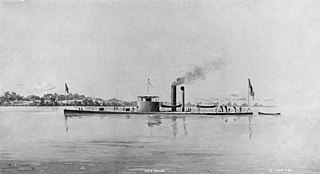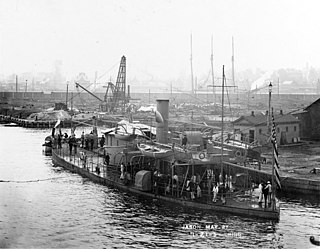See also
- Canonicus-class monitor, a class of nine ships built for the Union Navy during the American Civil War
Four ships of the United States Navy have been named Canonicus for Canonicus, a chief of the Narragansett Indians, who befriended Roger Williams, and presented him with a large tract of land for the Rhode Island colony.
Four ships of the United States Navy have borne the name USS Tecumseh, in honor of Tecumseh, a Shawnee Indian chief.
USS Vesuvius may refer to:
TCG Mauvenet may refer to one of the following ships of the Turkish Navy:
Three vessels of the United States Navy have been named USS San Francisco, after the city of San Francisco, California.
The first USS Nantucket was a Passaic-class coastal monitor in the United States Navy.

USS Canonicus was a single-turret monitor built for the United States Navy during the American Civil War, the lead ship of her class. The ship spent most of her first year in service stationed up the James River, where she could support operations against Richmond and defend against a sortie by the Confederate ironclads of the James River Squadron. She engaged Confederate artillery batteries during the year and later participated in both attacks on Fort Fisher, defending the approaches to Wilmington, North Carolina, from December 1864 to January 1865.
Canonicus (ACM-12) was a Camanche-class auxiliary minelayer in the United States Navy. It was named for Canonicus, a chief of the Narragansett Indians.
USS Montgomery may refer to the following ships of the United States Navy:

The first Passaic was a single turreted, coastal monitor purchased by the United States Navy for service during the American Civil War.
Four ships in the United States Navy have been named USS Gwin for William Gwin.
USS Terror may refer to the following ships operated by the United States Navy:

USS Sangamon was a Passaic-class ironclad monitor constructed for the Union Navy during the second year of the American Civil War where she operated in the waterways of the Confederate States of America. She was later recommissioned and placed into service during the Spanish–American War.

USS Catskill was a monitor built for the United States Navy during the American Civil War. She continued to serve the Navy after the war's end until decommissioned in 1898 after the end of the Spanish–American War.
USS Camanche may refer to the following ships of the United States Navy:

The Canonicus-class or Tippecanoe-class was a class of nine monitors built for the Union Navy during the American Civil War. An improvement on the preceding Passaics, modified in accordance with war experience, each vessel mounted two 15-inch (381 mm) Dahlgren guns. The five ships commissioned during the war participated variously in the Bermuda Hundred Campaign, the Battle of Mobile Bay and the First and Second Battles of Fort Fisher. When attacking the ironclad ram CSS Tennessee in 1865, the monitor Tecumseh was sunk by a naval mine, then termed a "torpedo". 94 died. Eight of the suspected conspirators for the assassination of Abraham Lincoln were incarcerated aboard Saugus and the monitor Montauk before they were transferred to the Arsenal Penitentiary. The remaining four ships not commissioned during the war were built on the Ohio River, three at Cincinnati, and Ajax at South Pittsburgh. Of these, Catawba and Oneota, renamed Atahualpa and Manco Cápac respectively, were sold to the Peruvian Navy and participated in the War of the Pacific, both being scuttled to prevent their capture by the Chilean Navy. The last remaining member of the class, the lead ship Canonicus, was an exhibit during the Jamestown Exposition, before being sold to the broken up in 1908.
USS Wyandotte is a name used for two ships of the United States Navy:
Three ships of the United States Navy have been named Saugus:
USS Tippecanoe may refer to the following ships operated by the United States:
Canonicus was a Native American chief of the Narragansett.

The second USS Canonicus was the Southern Pacific freighter El Cid temporarily converted for planting the World War I North Sea Mine Barrage. Newport News Shipbuilding and Dry Dock Company launched El Cid at Newport News, Virginia on 7 October 1899 for service between New York City and Gulf of Mexico seaports of New Orleans and Galveston, Texas. The United States Shipping Board took control of the ship from Southern Pacific Steamship Company in 1917.